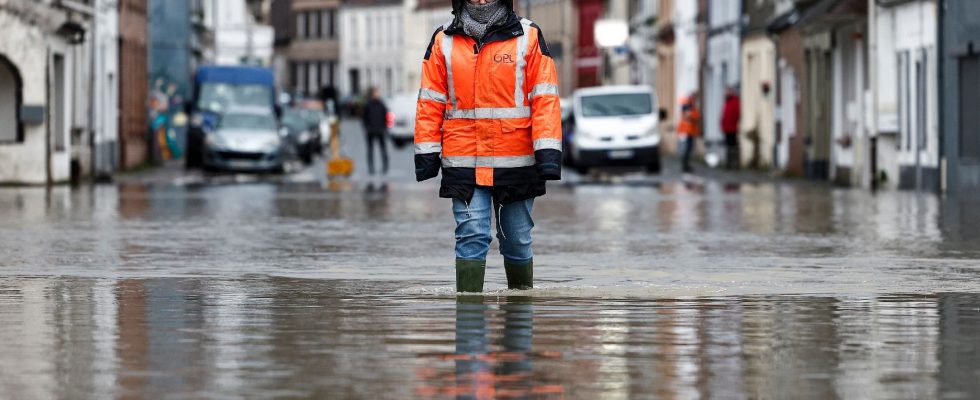Erik Lequime rubs his hands. Its inflatable evacuation bed, exhibited at the Mayors’ Show at Porte de Versailles in Paris, was a great success. “Elected officials from Var, Hérault, Pas-de-Calais and overseas territories are interested in it,” assures the entrepreneur. Some have even come to the stand several times to find out.”
Operational in the mountains, towable on the road using wheels, the device is also waterproof. Ideal for medical evacuations in the event of flooding. And it is this function that particularly interests mayors. Because the extraordinary rains which recently hit several regions of France still haunt people’s minds. And with them the feeling that an unleashed nature remains impossible to control.
“We have to put ourselves in the place of local elected officials. It’s not an easy situation,” confides Pascal Berteaud, general director of the Center for Studies and Expertise on Risks, the Environment, Mobility and Planning. (Cerema). When it comes to fighting floods, there is no perfect solution.” For a long time, France erected dams and dikes hoping to channel the waters that were a little too tumultuous while protecting homes. These systems are now showing their limits. By giving populations a feeling of security, they ultimately encouraged the development of activities in risk areas. They also modified the flow of sediments at the mouths of rivers, sometimes leading to land subsidence in certain inhabited areas. “Everyone easily understands the principle of a dike. However, studies show that they accelerate the speed of water and can increase the risk of flooding downstream. They therefore transfer the problem to another area”, explains Julien Boulange, professor at the Tokyo University of Agriculture and Technology.
Future population movements
Today, the trend is therefore rather to limit these solutions. “The municipalities are now using several levers, explains Pascal Berteaud: modification of buildings (raising the height when possible, integration of a roof exit to facilitate evacuations, etc.), maintaining permanent structures to channel floods and in place of buffer spaces to absorb excess water as much as possible. “For example, it could be a mangrove along the river. In this case, we keep a dike but we build it further away,” explains Julien Boulange. This type of configuration can generate co-benefits (preservation of biodiversity, greater resilience to droughts). However, it There is no 100% effective combination. And what works in one place does not necessarily work a few kilometers further away. A headache for mayors faced with high flood risks.
“We transferred the management of this problem to the municipalities. This is undoubtedly the right scale but initially, there were difficulties,” recognizes Pascal Berteaud. Apart from administrative complications, it is not always easy to convince the population. “Go tell an owner that his land will serve as a flood zone so that others can keep their feet dry,” confides a European source, who nevertheless sees more and more elected officials taking measures and coordinating more effectively on field. “Talking about a buffer zone is not very glamorous. For local residents, it means less clear river edges. Direct access to water becomes more difficult,” notes Antoine Yeretzian, Director of Development & Partnerships for Axa. Climate.
At least the local population can still live there. But in some places it won’t last. “In Charente or in other departments, there are already areas which have experienced 3 or 4 severe floods in recent times. Imagine what this could look like in several decades if major storms occur once a year. A trip of population will be necessary”, slips an expert.
“The State will compensate us”
A speech that is too alarmist? “We know that in the future, the costs linked to flooding will increase significantly due to climate change,” replies Julien Boulange. “Certain coastal areas pose a problem. During periods of flooding, sea levels tend to be higher as well, which favors submersion. Faced with this, dikes will not always be sufficient,” warns Pascal Berteaud.
And the expert tells us the story of this mayor faced with the risk of submersion, despite the presence of permanent protection in the town. Before taking new measures, the elected official wants to know precisely which houses will be affected in the event of a disaster. “But it’s impossible to have this information. There are too many uncertainties,” admits Pascal Berteaud. Another specialist tells us how certain villas located on the Atlantic coast are being snapped up at high prices even though they will be threatened by rising water levels in a few decades. “The State will compensate us,” some owners want to believe. A daring bet but not unfounded.
“In Japan, where flooding is the subject of numerous investments, everything is done to protect Tokyo, even if this means that the waters will flood the small villages located nearby. Financial compensation is being put in place to justify this approach based on the fact that the capital concentrates more and more inhabitants and activities. I think that this problem will also arise in Europe at least for the large metropolises”, warns Julien Boulange. “There is an inequality aspect to this problem that we do not talk about enough,” adds the scientist. “But in the future, this will undoubtedly become a key element.”
.
